During the Iron Age, people were sacrificed in quantity in the swamps of northwestern Europe, victims of ritual executions or punishments. A new study returns to the examination of one of the most famous cases, that of the Tollund Man.
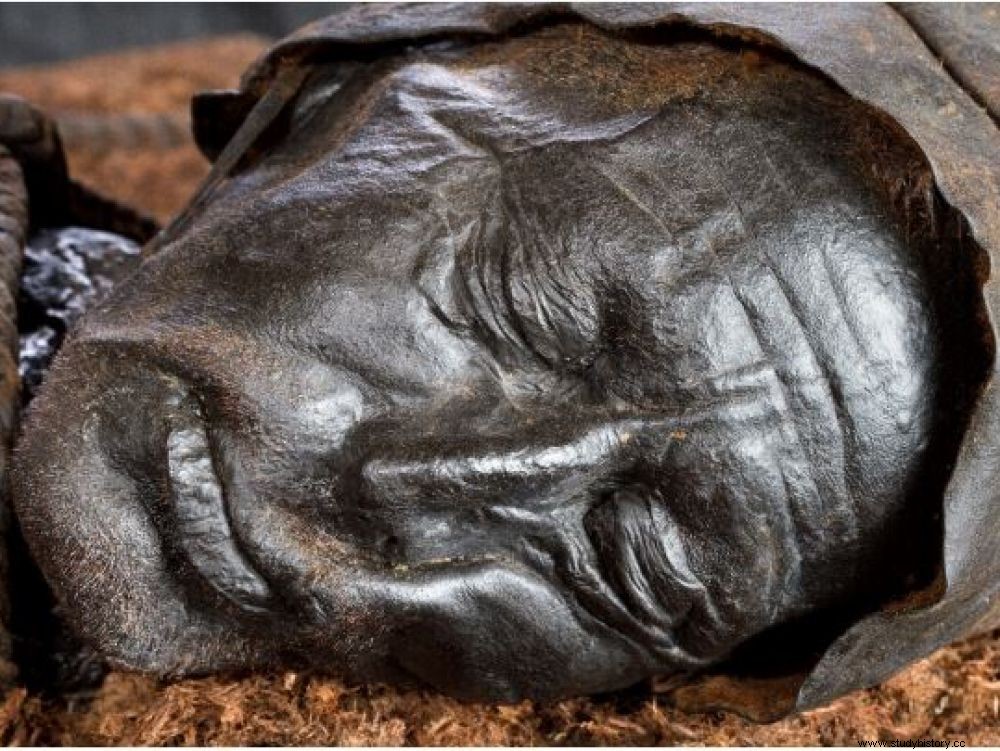
2400 years old, Tollund Man was discovered in a bog in Jutland, Denmark, in 1950.
In Europe, bog bodies, naturally mummified (bog bodies ), represent an archaeological treasure. Still provided with hair, skin and sometimes even clothing, they provide unique information for understanding prehistoric societies. A team of researchers from the Silkeborg Museum in Denmark has just published in the journal Antiquity the analysis of the last meal of the famous Man of Tollund. This is one of hundreds of bodies of men and women unearthed from bogs since the 18th century, the majority having been executed in the Iron Age (800 BC - 1st century AD) .
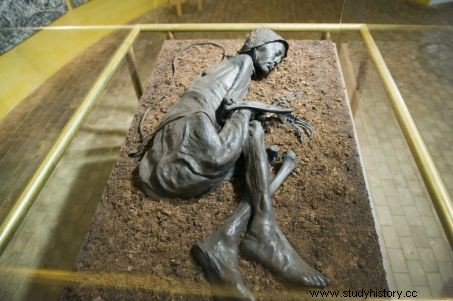
The preserved body of Tollund Man, an Iron Age bog mummy, now on display at Silkeborg Museum (Denmark). Credits:Christian Kober / Robert Harding Heritage / AFP
Incredibly well-preserved bodies
Extracted from the marshes of northwestern Europe, particularly in Scandinavia and the British Isles, these bodies have been admirably spared the ravages of time thanks to the physical and biochemical composition of the peat in which they were kept, a fuel derived from the fossilization of plants with low oxygen content. It was in 1950 at the site of "Tollund Fen", in Bjaedskovdal, in the Jutland peninsula, that Tollund Man was found. At the time, the energy shortage due to the Second World War had favored the extraction of peat to heat homes. Wearing a simple cap and a leather band around his waist, the man seemed to have been sleeping for 2400 years. Only a rope still tied around his neck indicated that this man in his forties, who died between 405-380 BC, had been tortured, as were most bog bodies. During the early Danish Iron Age (500 BC-200 AD), men and women were indeed sacrificed in swamps in violent rituals, stabbed, cut their throats, beaten or still hanged. The Latin author Tacitus thus evokes these immolations by "precipitation in marshes " within the Celtic and Germanic tribes "where the cowards, fugitives and those who lacked ardor in battle were executed" .
In Europe, bog bodies, naturally mummified (bog bodies ), represent an archaeological treasure. Still provided with hair, skin and sometimes even clothing, they provide unique information for understanding prehistoric societies. A team of researchers from the Silkeborg Museum in Denmark has just published in the journal Antiquity the analysis of the last meal of the famous Man of Tollund. This is one of hundreds of bodies of men and women exhumed from bogs since the 18th century, the majority having been executed in the Iron Age (800 BC - 1 st > century AD).

The preserved body of Tollund Man, an Iron Age bog mummy, now on display at Silkeborg Museum (Denmark). Credits:Christian Kober / Robert Harding Heritage / AFP
Incredibly well-preserved bodies
Extracted from the marshes of northwestern Europe, particularly in Scandinavia and the British Isles, these bodies have been admirably spared the ravages of time thanks to the physical and biochemical composition of the peat in which they were kept, a fuel derived from the fossilization of plants with low oxygen content. It was in 1950 at the site of "Tollund Fen", in Bjaedskovdal, in the Jutland peninsula, that Tollund Man was found. At the time, the energy shortage due to the Second World War had favored the extraction of peat to heat homes. Wearing a simple cap and a leather band around his waist, the man seemed to have been sleeping for 2400 years. Only a rope still tied around his neck indicated that this man in his forties, who died between 405-380 BC, had been tortured, as were most bog bodies. During the early Danish Iron Age (500 BC-200 AD), men and women were indeed sacrificed in swamps in violent rituals, stabbed, cut their throats, beaten or still hanged. The Latin author Tacitus thus evokes these immolations by "precipitation in marshes " within the Celtic and Germanic tribes "where the cowards, fugitives and those who lacked ardor in battle were executed" .
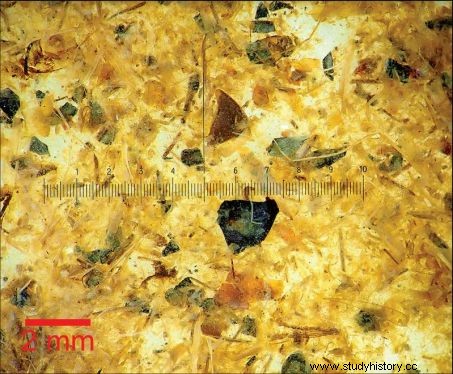
Photomicrograph of the intestinal contents of Tollund Man. Credits:P.S Henriksen / Danish National Museum / Antiquity
So what did the study of Tollund Man, whose internal organs were totally preserved, reveal? By re-examining the contents of his intestines under a microscope, specialists at the Silkeborg Museum have precisely established what he had consumed 12 to 24 hours before his death. "A first study was carried out in the 1950s, but the progress of knowledge on plant macrofossils and current analysis methods led us to carry out a new expertise its intestinal contents", explains Dr. Nina H. Nielsen of the Museum of Silkeborg, the main author of the article.
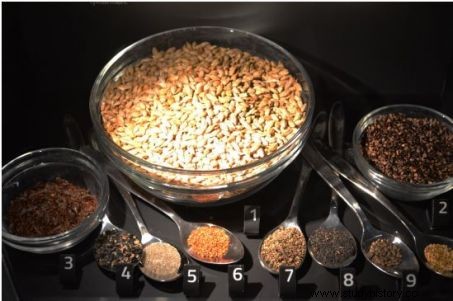
The main ingredients identified (excluding fish) of the last meal of the Man of Tollund:barley, persicary, flax, black bindweed, Camelina, hemp nettle etc. Credits:Silkeborg Museum / Antiquity.
"We can almost imagine, in an incredible snapshot of life, the moment when this preparation was cooked"
Its entrails contained the remains of an 85% barley gruel (Hordeum vulgare ) and oats (Avenas sp.) with 5% linseed (Linum usitatissimum ), and several taxa of wild herbs in low numbers:camelina (Camelina sativa ), lady's-thumb (Persicaria lapathifolia s.l ), but also black bindweed (Fallopia convolvus ), field spergule (Spergula arvensis ), white anserine (Chenopodium album ), wild turnip (Brassica rapa ), hemp-nettle (Galeopsis sp.) and field pansy (Viola arvensis). "This meal also included fish, and the porridge was cooked in a clay pot. We can almost imagine, in an incredible snapshot of life, the moment when this preparation was cooked" , writes Nina H. Nielsen. The results obtained also contributed to establishing that Tollund Man suffered from parasitism, and that he was infected by Ascaris-type nematodes and whipworms (Trichuris trichiura) , as well as a flatworm, tapeworm, reported here for the first time in a bog body. These infestations reflect the poor sanitary condition of this victim of the Iron Age, who may have been subjected to the consumption of undercooked meat or contaminated food and water.
One of the objectives of these investigations was also to look for the possible presence of unusual elements that could be linked to sacrificial rituals. This aspect of the work does not appear to have yielded conclusive data. The absence of traces of summer or autumn fruits among the food remains -as has been observed on other bodies in the marshes- could on the other hand indicate that the Tollund Man was killed in winter. Ancient authors have also reported bloody rituals at this time of year. The remains were also not accompanied by any ritual object, contrary to what is sometimes encountered for other remains found with precious objects (ankle rings, bracelets, necklaces).
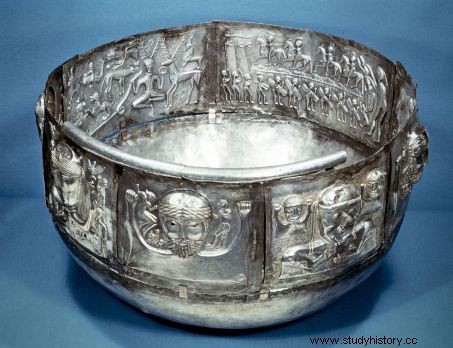
Dated to the 2nd century BCE, the 'Gundestrup Cauldron' was discovered in a swamp in Denmark in the 19th century. Made up of 13 silver plates, it is kept in the National Museum of Denmark in Copenhagen, where it is one of the most famous pieces. Credits:Ann Ronan Picture Library / photo 12/ AFP
Thus had been recovered in 1891 alongside the bodies of a man and two women in the Gundestrup swamp, in Denmark, fragments of metal, which once restored turned out to be those of an exceptional silver cauldron. Known as the "Cauldron of Gundestrup", this votive offering dating from 200 BC has brought to life the remarkable scenes that decorated its walls, including... human sacrifices. This confirms that the bog mummies were indeed sacrificed individuals, whether they were criminals sentenced to death or not.
